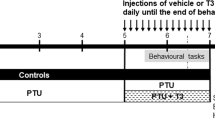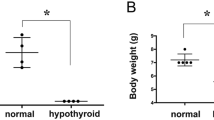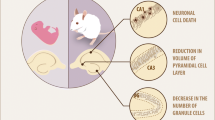Abstract
Recent data have shown that fine regulation of retinoid mediated gene expression is fundamentally important for optimal brain functioning in aged mice. Nevertheless, alteration of the thyroid hormone signalling pathway may be a limiting factor, which impedes retinoic acid (RA) from exerting its modulating effect. Mild hypothyroidism is often described in the elderly. Thus, in the present study, it was of interest to determine if RA exerts its neurological modulating effect in mild hypothyroidism. To obtain further insight into this question, mice were submitted to a low propylthiouracyl (PTU) drink (0.05%) in order to slightly reduce the serum level of triiodothyronine (T3). A quantitative evaluation of RA nuclear receptors (RAR, RXR), T3 nuclear receptor (TR) and of neurogranin (RC3, a RA target gene which codes for a protein considered as a good marker of synaptic plasticity) in PTU treated mice injected with vehicle or RA or T3 was carried out. The PTU-related decrease in expression of RAR, RXR and RC3 was restored following RA or T3 administration, as observed in aged mice. The amount of TR mRNA, which was not affected in PTU treated mice, was increased only after T3 treatment as observed in overt hypothyroidism. These results suggest that neurobiological alterations observed in aged mice are probably related to RA and T3 signalling pathway modifications associated, in part, with mild changes in thyroid function.
Resumen
Datos recientes indican la importancia de la regulación de la expresión génica por retinoides para el adecuado functionamiento cerebral en ratones viejos. La alteración de la vía de señalización de la hormonas tiroidea puede ser un factor limitante que impida la acción moduladora del ácido retinoico (RA) y es frecuente un moderado hipotiroidismo en la vejez. Por ello, se determina en este trabajo si el ácido retinoico ejerce su efecto neurológico modulador en la vejez. Con ese objetivo, a los ratones tratados se les administra en la bebida propiltiouracilo (0,05%), para reducir débilmente el nivel sérico de triyodotironina (T3), con ulterior administración en algunos casos de RA o de T3. Tanto en los ratones controles como en los tratados, se verifica una evaluación cuantitativa de los receptores nucleares de ácido retinoico (RAR, RXR) y de T3 (TR) y de neurogranina (RC3, un gen diana del ácido retinoico que codifica la proteína, considerada un buen marcador de la plasticidad sináptica). Los resultados muestran que el descenso de la expresión de RAR, RXR y RC3 relacionado con la administración de propiltiouracilo se restaura por administración de T3 o RA, como se observaba en animales viejos. La cantidad de RNAm de TR, que no se modificaba en los animales tratados con propiltiouracilo, aumenta sólo tras administración de T3. Los resultados sugieren que las alteraciones observadas en los ratones de edad avanzada se relacionan con modificaciones de la vía de señalización del RA y T3, con débiles cambios en la función tiroidea.
Similar content being viewed by others
References
Alfos S., Higueret P., Pallet V., Higueret D., Garcin H. and Jaffard R. (1996):Neurosci. Lett.,206, 73–76.
Bonet M. L., Ribot J., Felipe F. and Palou A. (2003):Cell. Mol. Life Sci.,60, 1311–1321.
Bradford M. (1976):Anal. Biochem.,72, 248–254.
Brent G. A., Dunn M. K., Harney J. W., Gulick T., Larsen P. R. and Moore D. D. (1989):New Biol.,1, 329–336.
Chin W. W. and Yen, P. M. (1997): In “Contemporary Endocrinology: Diseases of the Thyroid.”. (Braverman, L. E., ed.). Humana Press Inc., Totowa NJ, pp. 1–15.
Chiocca E. A., Davies P. J. A. and Stein J. P. (1989):J. Cell. Biochem.,39, 293–304.
Coustaut, M., Pallet, V., Garcin, H. and Higueret, P. (1996):Brit. J. Nutr.,76, 295–306.
Duncan, D. J., Stern, R. A. and Flashman, L. A. (2003):Current Psych. Report,5, 384–390.
Enderlin, V., Pallet, V., Alfos, S., Dargelos, E., Jaffard, R., Garcin, H. and Higueret, P. (1997):Neurosci. Lett.,229, 1–5.
Etchamendy, N., Enderlin, V., Marighetto, A., Vouimba, R. M., Pallet, V., Jaffard, R. and Higueret, P. (2001):J. Neurosci. 2, 6423–6429.
Etchamendy, N., Enderlin, V., Marighetto, A., Pallet, V., Higueret, P. and Jaffard, R. (2003):Behav. Brain Res.,145, 37–49.
Gentile, V., Saydak, M., Chiocca, M., Akande, O., Birbickbichler, P. J., Lee, K. N., Stein, J. J. and Davies, P. J. A. (1991):J. Biol. Chem.,266, 478–483.
Guadaño-Ferraz, A., Escamez, M. J., Morte, B., Vargiu, P. and Bernal, J. (1997):Mol. Brain Res.,49, 37–44.
Helton, T. E. and Magner, J. A. (1994):Endocrinology,135, 1980–1985.
Husson, M., Enderlin, V., Alfos, S., Feart, C., Higueret, P. and Pallet, V. (2003):Brit. J. Nutr.,90, 1–9.
Iannacone, E. A., Yan, A. W., Gauger, K. J., Dowling, A. L. S. and Zoeller, R. T. (2002):Mol. Cell. Endocrinol.,186, 49–59.
Iñiguez, M. A., Morte, B., Rodriguez-Peña, A., Munoz, A., Gerendasy, D., Sutcliffe, J. G. and Bernal, J. (1994):Mol. Brain Res.,27, 205–214.
Lebel, J. M., L’Hérault, S., Dussault, J. H. and Puymirat, J. (1993):Glia,9, 105–112.
Mangelsdorf, D. J., Borgmeyer, U., Heyman, R. A., Zhou, J. Y., Ong, E. S., Oro, A. E., Kakizuka, A. and Evans R. M. (1992):Gene Dev.,6, 329–344.
Mano, H., Mori, R., Osawa, T., Takeyama, K. I., Yoshizawa, Y., Kojima, R., Arao, Y., Masushige, S. and Kato, S. (1994):J. Biol. Chem.,269, 1591–1594.
Marill, J., Idres, N., Capron, C. C., Nguyen, E. and Chabot, G. G. (2003):Curr. Drug Metab.,4, 1–10.
Martinez de Arrieta, C., Morte, B., Coloma, A. and Bernal, J. (1999):Endocrinology,140, 335–343.
Mons, N., Enderlin, V., Jaffard, R. and Higueret, P. (2001):J. Neurochem. 79, 859–867.
Morte, B., Iñiguez, M. A., Lorenzo, P. I. and Bernal, J. (1997):J. Neurochem.,69, 902–909.
Nobrega, J. N., Raymond, R., Puymirat, J., Belej, T. and Joffe, R. T. (1997):Brain Res.,761, 161–164.
Piacentini, M., Sartori, C., Beninati, S., Bargagli, A. M. and Ceru-Argento, M. P. (1986):Biochem. J.,234, 435–40.
Prost, E., Koening, R. J., Moore, D. D., Larsen, P. R. and Whalen, R. G. (1988):Nucleic Acids Res.,13, 6248–6248.
Puymirat, J., Miehe, M., Marchand, R., Sarlieve, L. and Dussault, J. H. (1991):Thyroid,1, 173–184.
Redonnet, A., Bonilla, S., Noël-Suberville, C., Pallet, V., Dabadie, H., Gin, H. and Higueret, P. (2002):Int. J. Obesity,26, 920–927.
Silva, E. S., Astier, H., Thakare, U., Schartz, H. L. and Oppenheimer, J. H. (1977):J. Biol. Chem.,252, 6799–6805.
Stockigt, J. R. (2002):Clin. Chim. Acta,315, 111–124.
Sutherland, M. K., Wong, L., Somerville, M. J., Handley, P., Yoong, L., Bergeron, C. and Crapper McLachlan, D. R. (1992):Neurobiol. Aging,13, 301–312.
Weiss, R. E., Forrest, D., Pohlenz, J., Cua, K., Curran, T. and Refetoff, S. (1997):Endocrinology,138, 3624–3629.
Yagamata, T., Momoi, T., Kumagai, H., Nishikawa, T., Yanagisawa, M. and Momoi, M. (1993):Biomed. Res.,14, 183–190.
Yen, P. M. (2001):Physiol. Rev.,81, 1097–1142.
Author information
Authors and Affiliations
Corresponding author
Rights and permissions
About this article
Cite this article
Enderlin, V., Vallortigara, J., Alfos, S. et al. Retinoic acid reverses the PTU related decrease in neurogranin level in mice brain. J. Physiol. Biochem. 60, 191–198 (2004). https://doi.org/10.1007/BF03167028
Received:
Issue Date:
DOI: https://doi.org/10.1007/BF03167028




